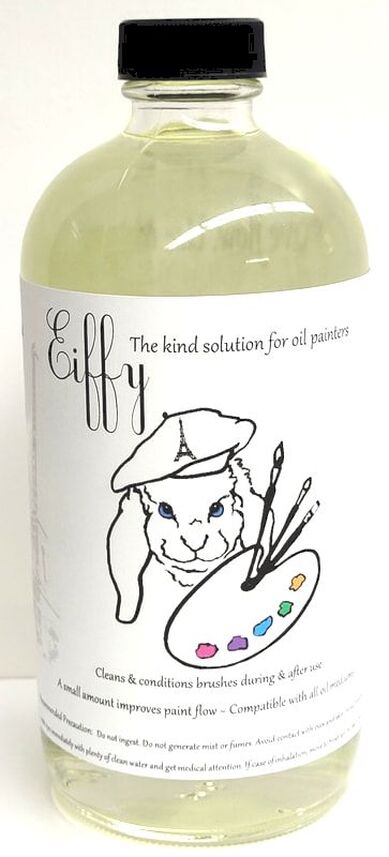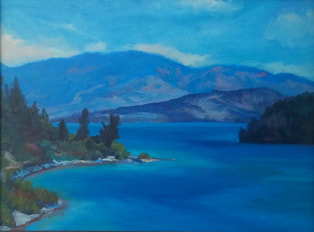Eiffy Brush Cleaning Oil
Hop over to Eiffy, the kind solution and paint with peace of mind,
knowing that you are being
Kind to your health
Kind to the earth
Kind to your art
knowing that you are being
Kind to your health
Kind to the earth
Kind to your art
Buy a bottle today!
Stop by one of my studio art classes and pick some up.
You can choose from a 16oz bottle for $25.
Out of town, or want to gift it to a friend? I am happy to ship. BUY A BOTTLE.
Coming to an art supply store near you
You can choose from a 16oz bottle for $25.
Out of town, or want to gift it to a friend? I am happy to ship. BUY A BOTTLE.
Coming to an art supply store near you
|
In Art, Oil paint is my first love. And to think, there was a time I contemplated getting rid of all of my oils because I couldn't bare the toxic air. |
What can it do?It has a consistency close to water. It is highly effective in cleaning oil paint out of brushes during and after painting.
Small amounts can be added to the paint to thin it out without effecting the drying time of your painting. As with adding any oil to your paint, if too much is added, it will eventually dry, but will slow down the drying time. This oil solvent dries through absorption. The oil is absorbed by the paint pigments and gesso primer. Cotton canvas with acrylic gesso absorbs it well. Oil primed linen does NOT absorb it well, so less should be added to the paint if you are using an oil primed linen canvas. Though non-toxic, it has been stripped down to the point that it is a SOLVENT, so if contact occurs, it may irritate the skin or eyes. If irritation occurs, rinse the area with water. If rash occurs, seek medical attention. |
What it can't do
Because this solvent is a cleaning OIL, in the world of painting, it is considered a "Fat". Therefore, it should not be used to create a wash for an underpainting. If you do add to much, you can blot or wipe off the excess oil. The timeless rule of "Fat OVER lean" applies here. Oil is FAT, so should be used sparingly in the first layers.
In the aspect of creating a paint wash, this plant-based solvent does not replace turpentine or OMS. They create fast evaporating washes, and it is these evaporative "VOC's" (Volatile Organic Compound) that are bad to breath.
There are, however, strong smelling "NON-TOXIC" alternatives that will evaporate quickly for creating "non- toxic" paint washes. These alternatives are 100% Rosemary or Spike Lavendar essential oils.
Eiffy conditions natural hair brushes like Hog Hair or Sabel, but the oily residue should be removed if you plan on not using them for several weeks. TO REMOVE THE OIL FROM THE CLEANED BRUSH, use ISOPROPYL (RUBBING) ALCOHOL. Pour a few ounces into a cup and clean the brush by stroking it in the liquid.
You can finish with a quick wash at the sink with your favorite brush cleaning soap.
In the aspect of creating a paint wash, this plant-based solvent does not replace turpentine or OMS. They create fast evaporating washes, and it is these evaporative "VOC's" (Volatile Organic Compound) that are bad to breath.
There are, however, strong smelling "NON-TOXIC" alternatives that will evaporate quickly for creating "non- toxic" paint washes. These alternatives are 100% Rosemary or Spike Lavendar essential oils.
Eiffy conditions natural hair brushes like Hog Hair or Sabel, but the oily residue should be removed if you plan on not using them for several weeks. TO REMOVE THE OIL FROM THE CLEANED BRUSH, use ISOPROPYL (RUBBING) ALCOHOL. Pour a few ounces into a cup and clean the brush by stroking it in the liquid.
You can finish with a quick wash at the sink with your favorite brush cleaning soap.
NON - TOXIC alternatives for paint washes#1 Before turpentine was widely used, artists used 100% Rosemary or Spike Lavender Essential oils to thin their paints and to make "Imprimatura" washes. These two essential oils are perfect for creating a wash, they evaporate within seconds, creating a very "lean" paint layer, perfect for painting over with subsequent layers of oil paint.
Most artists could not afford the high expense of essential oil over the last few hundred years, so they used Turpentine as a cheap substitute. Modern technology has made essential oil very affordable. As a curtesy, I do ask students to refrain from using the essential oils in group painting classes, as some students are highly sensitive to smells of any kind. #2 For the most part, oil paint can be used just as it comes out of the tube. An "Imprimatura" (thin, transparent tone) can be made by scribbling plain paint on the canvas with a stiff brush and wiped into the canvas with a rag. #3 If you are painting on an acrylic primed canvas, you can tone your canvas with a watered down acrylic solution and paint over it with oil paints. |
Recommended NON-Toxic & NON-Odor mediums available at Art Stores that can be used in my art classes:
- WALNUT ALKYD MEDIUM by M. Graham & Co.
- SOLVENT-FREE GEL by Gamblin
Reusable
|
When it gets dirty you can pour Eiffy into a clean jar and let it settle, pouring the clean liquid back into your paint thinner tank and wiping the settled paint out with a paper towel.
Settling time can range from sever days to a few weeks, depending on the size of the pigment particles in your paint. Don't want to bother with it? Bring your dirty painting oil by one of my art classes at the Oro Valley Community Center, I have a gallon jug for Eiffy Recycling. |
|
Are you as tired of killing brain cells as I am? Do you get headaches or feel ill after hours in the studio? I used to. Odorless mineral spirits, though “odorless” are terribly harmful to your health and weaken your paint. They are classified as a "narcotic" in that the side effects of breathing them can cause dizziness, confusion, headache, and nausea. They can also give your skin a chemical burn. Eiffy is not harmful to breath around for you, your family, pets, and fellow students. It is kid friendly and safe for the environment. |








